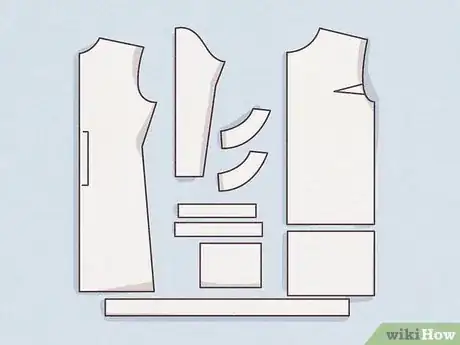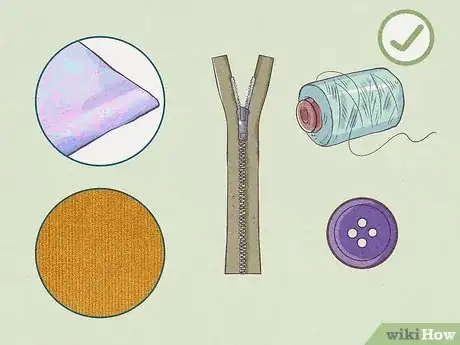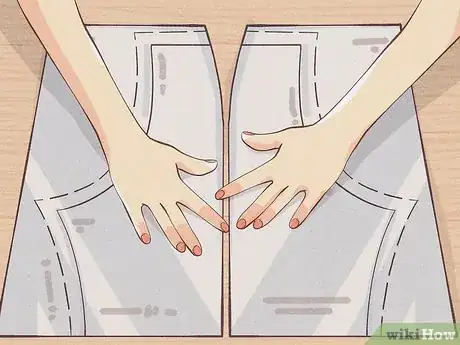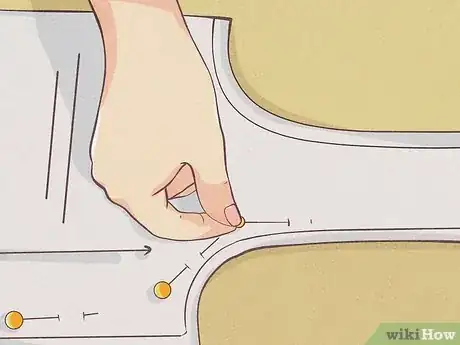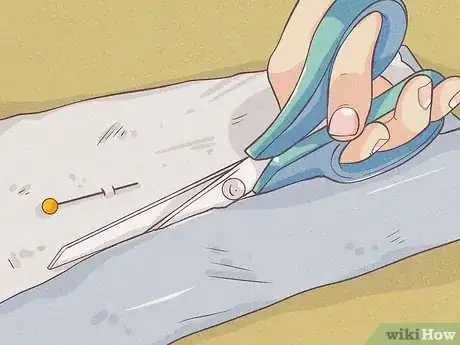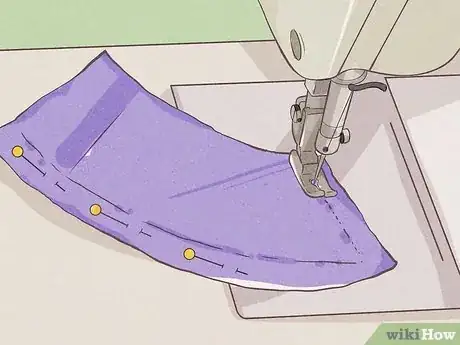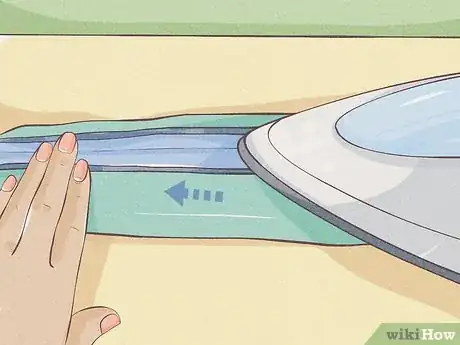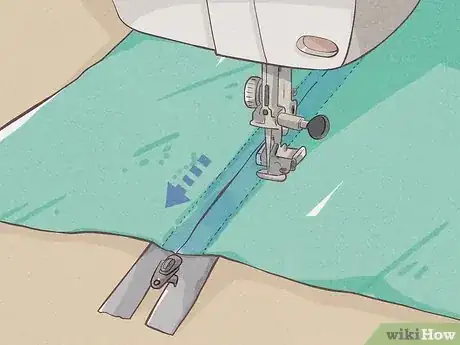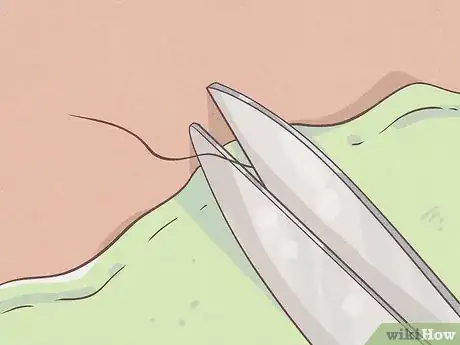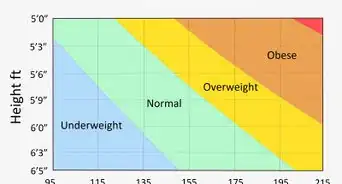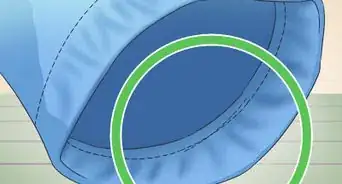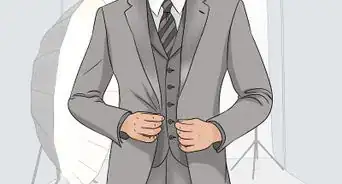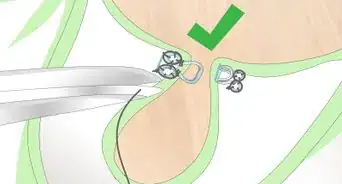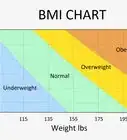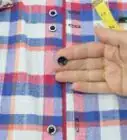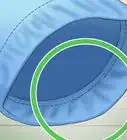This article was co-authored by Korri Burton-Universe. Korri Burton-Universe is a Professional Tailor and the Owner of Uncommon Closet, a custom clothing and tailor resource for the LGBTQIA+ community and those with body types often overlooked by major clothing chains and shops. Korri specializes in custom clothing, tailoring services, and wedding clothes for people of all identities, genders, races, and sizes. Uncommon Closet creates a safe space for people to find or make outfits that make them feel safe and powerful.
This article has been viewed 102,378 times.
A jacket is an advanced sewing project and it requires a pattern. The pattern will help to ensure that you make the jacket in the size and style that you need. Sewing a jacket also requires some special sewing skills, such as knowing how to read a sewing pattern, sew sleeves, and add closures like buttons and zippers.
Steps
Preparing the Fabric
-
1Choose your jacket pattern. There are many different patterns to choose from to use as a guide to make a jacket. If you are new to sewing, then try to find a pattern that is labeled as “easy” or “beginner” level.[1] Consider the style of the jacket pattern as well. Jackets come in many different lengths and with a variety of different details. Find a pattern that suits your style and needs.
- If you are a beginner, then try to find a jacket pattern that does not require interfacing or a lining. This will make the process much easier.[2] You may also want to avoid patterns with lots of pleating, special stitches, and complex closures.
-
2Purchase fabric and other necessary materials. The pattern will include a list of necessary materials to complete your project. Use this list to ensure that you get everything you will need before you get started. Some things your pattern may recommend purchasing include:
- Fabric for the outside of the jacket. Your pattern may suggest several different fabric options and you can choose the one that best suits your intentions for the jacket. For example, if you want a warm winter jacket, then a wool or corduroy fabric may be your best option, but if you want a light spring jacket, then a cotton or denim may be best.[3]
- Fabric for lining the jacket
- Interfacing to go in between the two layers
- Buttons, snaps, or a zipper
- Thread in a color that matches your jacket’s fabric
Advertisement -
3Read the pattern instructions carefully. Before you begin sewing, it is always a good idea to read through all of the pattern’s instructions and make sure you understand what you will need to do to make your jacket. Highlight anything in the pattern instructions that is seems important, such as how to lay the fabric on the pattern pieces before cutting them out.
-
4Cut out the pattern pieces. When you are ready to sew, cut out the pattern pieces that you will need to create the jacket. Usually, patterns feature a few different designs and the different pieces are labeled with a letter, such as A, B, C, or D, to indicate which pieces go with a particular design. Check your design to find the letter of your desired design and then cut out the pieces that are labeled with this letter.
- If you have opted for an easy or beginner level pattern, then there should not be too many pieces to cut out. You will likely only have to cut out the pieces for the front, back, and sleeves of the jacket.[4]
-
5Pin the pattern pieces to your fabric. Each of the pattern pieces will indicate what type of fabric you need to cut it out of and also how to align the fabric on the pattern piece. For example, some pieces will need to be made from your outer fabric, lining fabric, and interfacing, while other pieces may only need to be made from the outer fabric and/or lining. The pattern will also indicate if you need to line up the piece along a fold in the fabric or if you can cut it out anywhere on the fabric.
- Place pins along the edges of the fabric only to avoid damaging the jacket fabric.
- If your material is especially delicate, then you may want to use binder clips or weights placed on the edges of the fabric and pattern pieces instead of pins.
-
6Cut the fabric along the edges of the pattern pieces. When you have finished pinning, cut along the edges of the pattern piece and fabric. Make sure to cut right along the edges of the lines and not inside or too far outside of them. Then, if you need to make another piece from a different type of material, pin the pattern to that fabric and cut out the next piece.
Assembling the Jacket Pieces
-
1Pin interfacing to the fabric pieces. Your pattern will indicate what to do after you have finished cutting out your pattern pieces, but you will likely need to pin the interfacing and/or lining pieces to their matching fabric pieces. Check the instructions to see if this is your next step, and if it is, then carefully line up the pieces and pin them together as indicated by your pattern.
- If your pattern does not require interfacing or lining, then you will not need to do this.
-
2Sew the lining, interfacing, and exterior fabric together. After you have pinned your interfacing and other fabric pieces as indicated by your pattern, use a sewing machine to sew along the edges of these pieces.[5] Make sure to check your pattern for the type of stitch you will need to use because different types of stitches may be required for different types of materials.
- For example, if you are using a stretch fabric, then you may need to use a narrow zigzag stitch.
- Keep in mind that you may not need to do this at all if your pattern does not require lining or interfacing.
-
3Pin the jacket's body pieces together. Your pattern will indicate how to pin the front, back, and any other body pieces together in preparation for sewing. You will most likely need to pin adjoining pieces so that the outer fabric pieces are facing each other. Make sure to pin the pieces through areas that will not be visible on the outside of the jacket. Your pattern should indicate where the seam allowance is and this is the ideal place to pin the pieces together.
-
4Sew along the edges. After you have pinned the pieces together, use a sewing machine to sew along the pinned areas as indicated by your pattern. Remember that your pattern may recommend using a special type of stitch to sew these areas depending on the type of fabric you are using.
- Remove the pins as you sew and make sure that you do not sew over any of the pins or you may damage your sewing machine.
-
5Sew the sleeves into place. The jacket pattern will provide detailed instructions on how to sew the sleeves in place for your jacket. If you have a lining and/or interfacing to add, then you should already have the pieces assembled and sewn together. Then, you can sew the sleeve into place. Check your pattern for specific instructions on how to sew the sleeves onto your jacket.
-
6Hem the sleeves. You may also need to hem the sleeves after you sew them if you have not done this already. To create a basic hem, fold the end of the sleeve into the sleeve by about 0.5 inches (1.3 cm). Then, use your sewing machine to sew the folded fabric into place inside of the jacket sleeve. This will hide the cut edges of the fabric.
- Make sure to check your pattern to see if any special stitches are required for hemming the sleeves.
Finishing the Jacket
-
1Press the seams. After you have assembled the pieces for your jacket, you may want to press the seams with an iron to give the jacket a neat finish. Use a low setting and place a t-shirt or towel between your fabric and the iron to protect the fabric from damage. Then, slowly run the iron along each of the seams to flatten them inside of the jacket.[6]
-
2Add your jacket closure. Your jacket’s pattern should indicate what type of closure it requires, and each closure will require a different process to install. Some closure options include:
-
3Trim off any loose threads. After you have completed your jacket, give it a second look and make sure there are no loose threads hanging from the seams. If there are, then trim them as close to the seams as possible without cutting into the fabric or threads in the seam.
- After you trim away any loose threads, your jacket is complete and ready to wear!
Expert Q&A
-
QuestionHow hard is it to sew a jacket?
 Korri Burton-UniverseKorri Burton-Universe is a Professional Tailor and the Owner of Uncommon Closet, a custom clothing and tailor resource for the LGBTQIA+ community and those with body types often overlooked by major clothing chains and shops. Korri specializes in custom clothing, tailoring services, and wedding clothes for people of all identities, genders, races, and sizes. Uncommon Closet creates a safe space for people to find or make outfits that make them feel safe and powerful.
Korri Burton-UniverseKorri Burton-Universe is a Professional Tailor and the Owner of Uncommon Closet, a custom clothing and tailor resource for the LGBTQIA+ community and those with body types often overlooked by major clothing chains and shops. Korri specializes in custom clothing, tailoring services, and wedding clothes for people of all identities, genders, races, and sizes. Uncommon Closet creates a safe space for people to find or make outfits that make them feel safe and powerful.
Professional Tailor You'll need to have some familiarity with working on a pattern, so make sure you choose an unstructured jacket or one that's labeled "beginner."
You'll need to have some familiarity with working on a pattern, so make sure you choose an unstructured jacket or one that's labeled "beginner." -
QuestionWhat fabrics do I need to make a high-tech jacket protecting me from extreme weather?Depending on your definition of extreme weather, the choice of fabrics can be varied. An outer layer like nylon protects from wind and wetness. An inner layer can vary, depending on the level of insulation and the desired weight of the garment. Brand-name fabrics have specific properties designed in their construction, like windproof fleece and wind- and waterproof nylon. Visit stores to see what is used in the type of garment desired in deciding on your selection of fabrics.
-
QuestionHow do I stitch a ladies blazer?The article provides the basic method for stitching a blazer. A pattern specific to the style you prefer will have step-by-step directions and order to assembling the garment. Take time to read the instructions to achieve a well-made garment.
Things You’ll Need
- Jacket pattern
- Fabric
- Pins
- Scissors
- Thread
- Closure such as a zipper, buttons, or snaps
- Sewing machine
References
- ↑ Korri Burton-Universe. Professional Tailor. Expert Interview. 12 January 2021.
- ↑ http://www.lovetosew.com/sewingcoats.htm
- ↑ http://www.lovetosew.com/sewingcoats.htm
- ↑ http://www.lovetosew.com/sewingcoats.htm
- ↑ http://www.threadsmagazine.com/2008/06/06/making-a-jacket-part-i
- ↑ http://www.threadsmagazine.com/2008/06/06/making-a-jacket-part-i
About This Article
Sewing a jacket is an advanced project that requires you to follow a sewing pattern to create the finished product. Try to find a pattern that’s labeled “Easy” or “Beginner” if this is your first jacket. Then, buy all of the supplies mentioned on the pattern. Once you’re ready to get started, pin the pattern pieces to your fabric and cut the fabric around the edges of the pattern. After you’ve cut all your pieces, follow your pattern’s instructions to sew all of the outer parts, intersections, and lining pieces together correctly. Then, pin the pieces together to create your jacket shape. Use a sewing machine to sew along all of the seams. When you’ve finished sewing, attach the sleeves and closure, like buttons or a zipper. For tips on how to press the seams of your jacket, keep reading!
